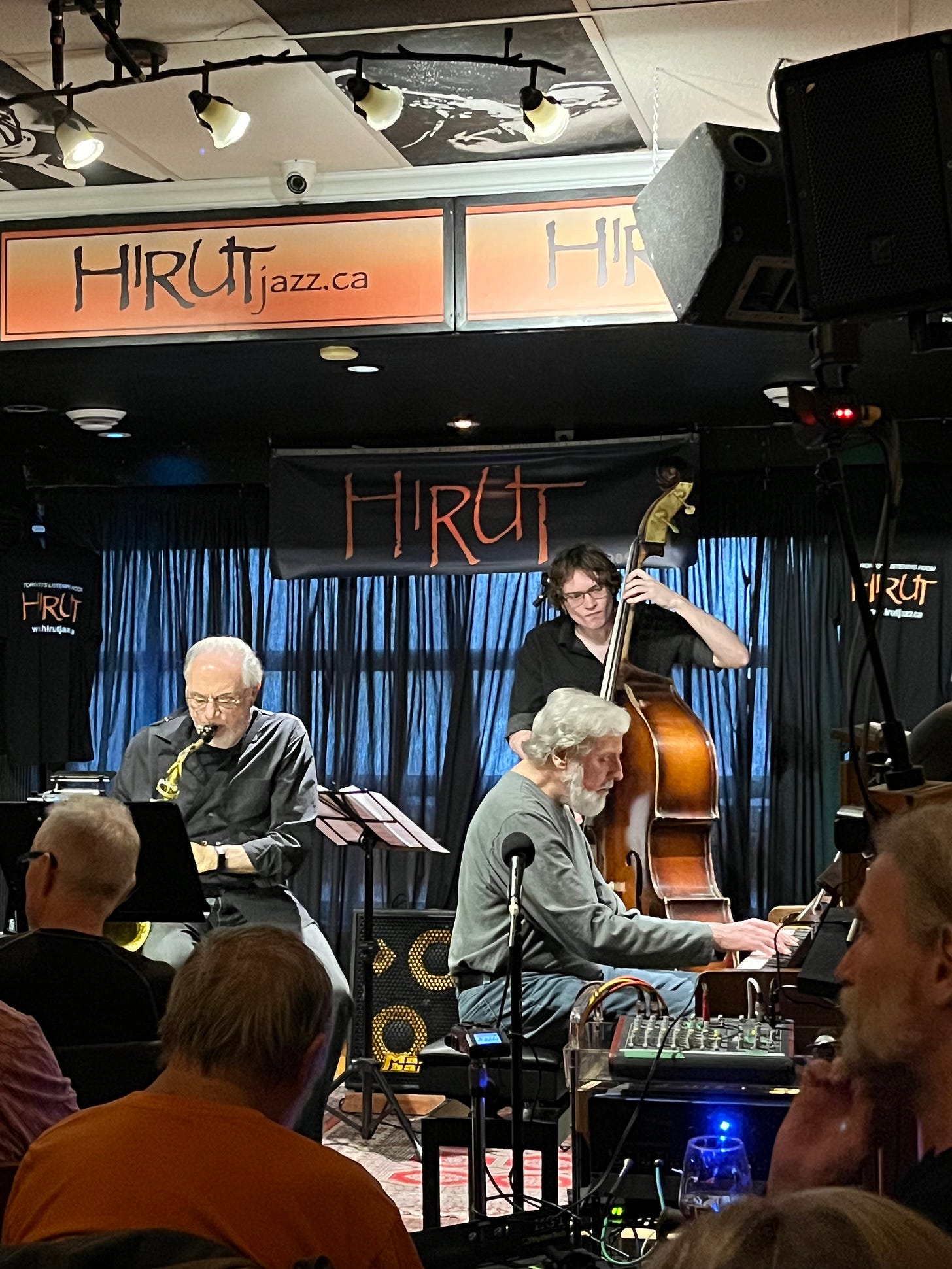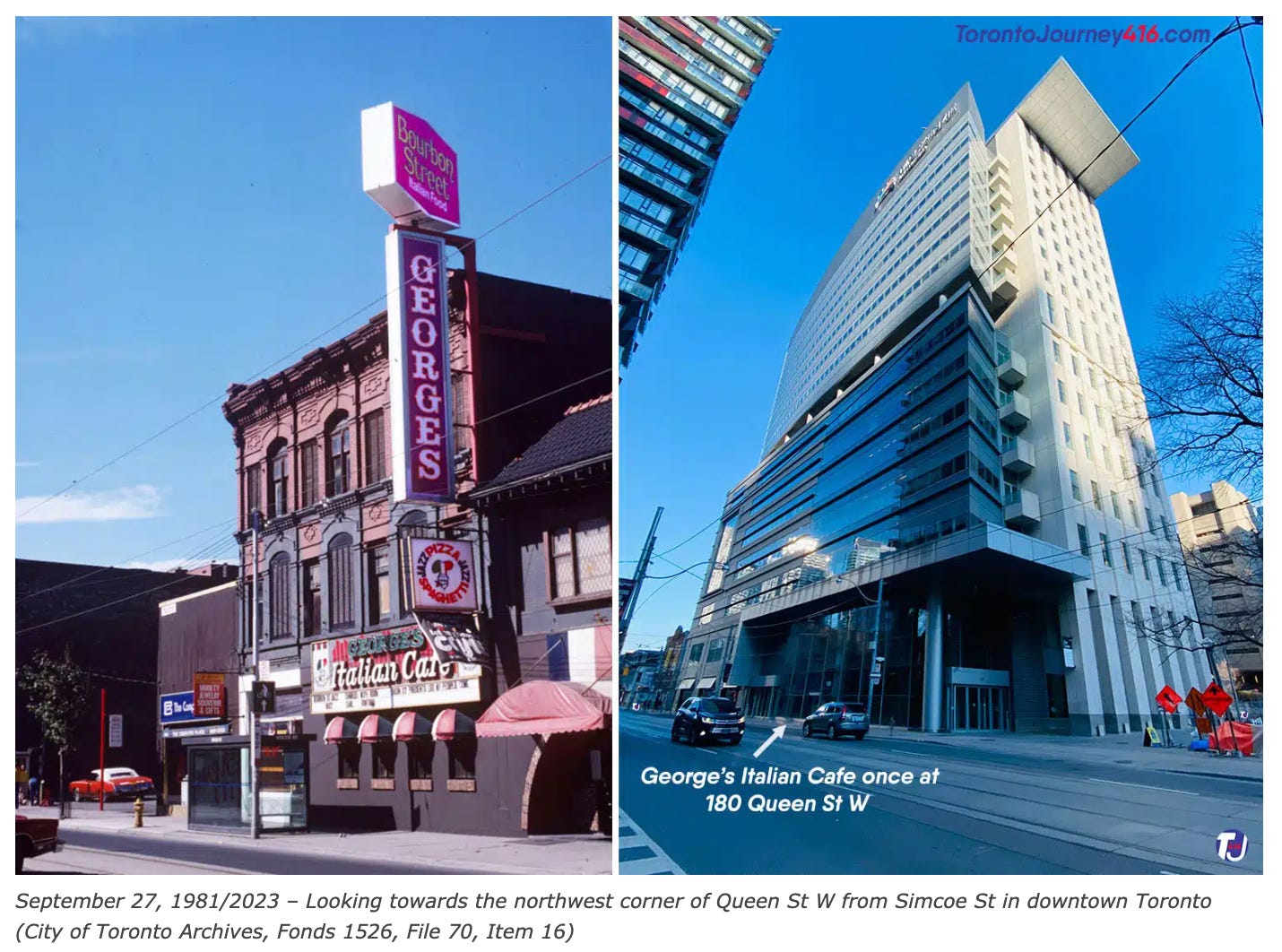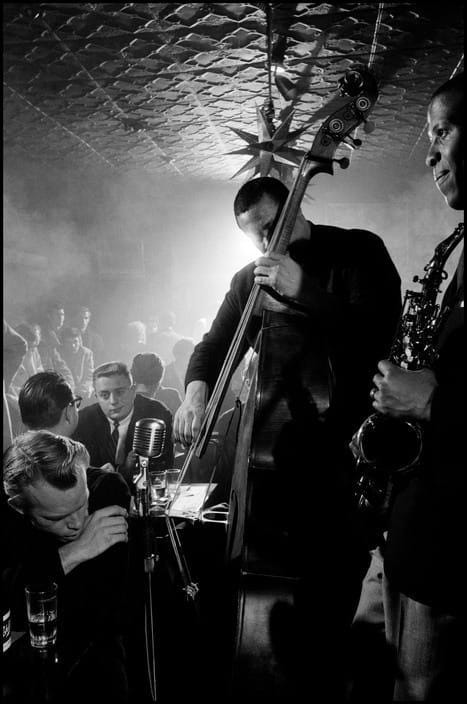027. Jim Hall Live! (recorded 1975) + John Handy Recorded Live at Monterey Jazz Festival (recorded 9/1965)
Profiling two albums featuring Canadians Don Thompson playing bass and Terry Clarke playing drums.
I got to see Don Thompson live last week, playing piano in a trio at HIRUT cafe, which is an Ethiopian restaurant-cum-jazz-club on Toronto’s east end. HIRUT features great live music every night of the week, and Thompson and Clarke perform there infrequently. There’s usually a $20 cover, but Thompson and his group charged $25 at the door. The food was great, the customer service friendly and welcoming, and the band swung hard, if a bit traditional. The crowd was mostly gray-haired, but a few younger folks were present (do I even qualify as “younger folks” now?). My wife and I stayed for the first set before dipping out to watch Game 4 of the NBA Finals. The young man on the bass is Chris Parnis, and I thought he was sharp and mostly kept up with legends Thompson and Labarbera. Parnis honours Thompson at this year’s Toronto Jazz Festival with his nonet on June 24 at the Jazz Bistro. More info here.
The fun part about this project for me has been to recognize Canadian talent in the Penguin Guide; not only as band leaders, but as featured sidemen as well. OG bassist Thompson and OG drummer Terry Clarke are featured on two fantastic albums that deserve a first listen for the newcomers, or a dive back in for the jazz connoisseurs. Paired together, Jim Hall Live!, and John Handy Live at the Monterrey Jazz Festival present a perfect yin and yang of sorts for Thompson and Clarke. Opposing energies, but equally grooving and introspective. The calm and the storm.
Jim Hall Live! (recorded 1975)
The first album, Jim Hall’s Live! (listen above) was recorded at the Bourbon Street Jazz Club in Toronto in 1975. It features the trio of guitar wizard Hall, Thompson on bass and Clarke on drums. Bourbon Street Jazz Club was located at 180 Queen St. West, operating between 1971 and 1986. Check out the image below which shows the location in 1981. It’s now been replaced by a run-of-the-mill glass and concrete tower with no specific identity or character. For a full article on George’s Spaghetti House and Bourbon Street venues, check out this great historical tribute from Denise Marie at Toronto Journey 416 website.
Bourbon Street and George’s Spaghetti House played host to talent from South of the border backed by Canadian house bands, which often included Thompson and Clarke.
Jim Hall Live! has five tracks, all well-known standards. But listening to the full album, each interpretation feels seamless and of its own making. The interplay between the musicians is relaxed and familial. Overall, it’s a great album to put on for a relaxed and nocturnal vibe, with Hall’s famously subtle guitar playing stepping in and out from a trio that always keeps it entertaining for the tuned-in ear. Great for studying or focussing on any task at hand. The Penguin Guide claims it’s “Nicely recorded, with a generous sound from the bass.”
According to Wikipedia, Pat Metheny calls Live! his favourite Jim Hall album and calls out both Thompson and Clarke for their playing and interplay with Hall.
If I had to pick one Jim record, it would be [Jim Hall Live!]....That was the ideal band, the ideal tunes, the ideal setting. Although Jim's had great periods all through his career, there was something going on right around that time that was incredible in his abilities, even on the instrument. There's stuff that he was playing right around that era that you really can't find him playing like before or after....It's a real portrait of that band. The whole thing with Don and Terry is so special, and it always has been for Jim. He's really affected by who he's playing with. Don is such a good soloist. You get to hear Jim comp a lot, which is great. Terry really understands how to play with guitar. That's something that is lost on a lot of drummers. It's not the same as playing with a tenor player. It's not the same as playing in a piano trio. Terry's always been great at that.1
I’d never heard of Jim Hall before, but I dig his style of playing. Hall once said:
“Players should force themselves to hear something and then play it, rather than just do whatever comes under their fingers. I try to make my playing as fresh as possible by not relying on set patterns.” 2
But this curiosity and determination for freshness comes through on the album in a quiet and compelling way. Give the album a listen (above)!
John Handy Recorded Live at Monterey Jazz Festival (recorded 9/1965)
The second album that features Thompson and Clarke is John Handy’s Recorded Live at the Monterey Jazz Festival. I’d never heard of this album, but according to the liner notes writer Ralph J. Gleason, it features “an exciting group and one of that will make jazz history.” Them’s large praises Mr. Gleason. The Penguin Guide claims, “The 1965 Monterey Jazz Festival appearance was a roaring success and should have created more critical momentum than the work of later years suggests.”
I was more familiar with the other Monterey Festival, Monterey Pop, and the classic music documentary filmed in 1967 by D.A. Pennebaker and his crew. "The festival is remembered for the first major American appearances by the Jimi Hendrix Experience, the Who, and Ravi Shankar, the first large-scale public performance of Janis Joplin, and the introduction of Otis Redding to a mass American audience.”3
Check it out here:
But two years earlier, John Handy and his group recorded Live at the Monterey Jazz Festival (3.5 stars, Penguin Guide). AllMusic gives the album 9.2/10, and according to Reddit user Genre-Fluid, “An absolutely beautiful performance in all its glory. Strings horns and percussion. It's long but has heartstrings moments. If you haven't heard it before then I envy you.”4
This is a wonderful album, with two tracks. “If Only We Knew” clocks in at over 27 minutes, while “Spanish Lady” hits just under 20 minutes. Handy rocks on the alto saxophone, while Mike White adds some spirited violin. Jerry Hahn plays guitar (his solo on “If Only We Knew” is special), and Thompson and Clarke round out the quintet. It’s really a lovely album that takes you places in your mind. Each musician has some truly in-your-soul solos that transcend categorization and hit you with immense feeling. It’s a heavy jam album made the year that the Grateful Dead was founded. I’m listening to this album while writing this post, I’m almost to the end now. The energy is actually incredible, especially on the second half of the second track. What a build. This is a must-listen of unclassifiable sounds, even klezmer vibes melting into military marching band at the tail end. Damn.
The album, listed as #67 out of 100 on Jazzwise’s 100 Jazz Albums That Shook the World list (here), is also featured in a humorous way in director Charles Burnett’s (Killer of Sheep5) short film, When it Rains (1995). Criterion describes the film as “a jazz- and poetry-inflected portrait of African American community and resilience via the story of a mother who enlists a musician’s help when she is evicted on New Year’s Day.”6 It’s a mundane celebration of blackness, which I appreciate. Check it out below. The album comes into play at approximately 10:30. It’s a a sneaky ode to a criminally overlooked album and document of live music from the 1960’s.
John Handy is now 92 years old! He’s the last surviving member of the famed Charles Mingus groups of 1958-1962. While Handy has always been a Bay Area guy, he spent formative years in New York City with Mingus and is featured on Jazz Portraits: Mingus in Wonderland , Blues and Roots, and Mingus Ah Um. For those interested in Handy’s experiences with Mingus, check out the article, “For Master Saxophonist John Handy’s 91st Birthday, a Testimony About His Experiences with Charles Mingus From 2022” from Ted Panken’s blog here.
For those in Toronto, don’t forget to check out the massive free lineup of music in Yorkville for the Toronto Jazz Festival. I’ll see you there.
https://en.wikipedia.org/wiki/Jim_Hall_Live!
https://web.archive.org/web/20170831101446/http://www.jazzguitarlessons.net/jim-hall.html
https://en.wikipedia.org/wiki/Monterey_International_Pop_Festival
https://www.reddit.com/r/Jazz/comments/1bxou96/john_handy_recorded_live_at_the_monterey_jazz/
Check out this recently-published New Yorker piece by Doreen St. Félix: https://www.newyorker.com/culture/critics-notebook/play-it-again-charles-burnett
Re: Killer of Sheep
In the early seventies, Burnett was developing in his mind a story that was not a story. Plot frustrated him. The demand for resolution, which for the Black character in Hollywood cinema meant either one of two things—noble spiritual cleansing or triumph over whitey—overlooked the day-in, day-out realities of ordinary people. A social realist, Burnett found the ultimate principle of moviemaking, which is the creation of drama, in the mundane. He did not want to make everyday people saints, as was the post-civil-rights-movement impulse. He wanted to portray Blackness as a mystery, recognizable but unquantifiable even to the people themselves. And although he is a storyteller, he wanted to show us who we were through images of granular detail: a boy drowning his corn cereal in sugar; more boys coming together to roughhouse on an empty railroad track; a man, his jeans riding low, laying linoleum under his sink; the wife of the man clinging to his hips, which are so clenched from working to provide, urging him to remember his other purpose…
https://www.criterionchannel.com/when-it-rains






